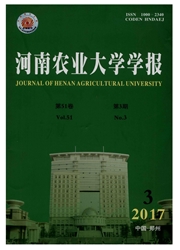

 中文摘要:
中文摘要:
利用单感受器记录技术测定了不同取食经历的棉铃虫幼虫对糖和肌醇的电生理反应,以分析昆虫味觉细胞的可塑性.研究结果表明,(1)连续多代取食含量约39mmol·L^-1蔗糖的标准人工饲料的棉铃虫幼虫下颚中栓锥感器和侧栓锥感器对阿拉伯糖、海藻糖、麦芽糖、葡萄糖和蔗糖均产生明显的脉冲反应,但中栓锥感器对海藻糖和葡萄糖的反应频率显著高于侧栓锥感器,表明中栓锥感器内存在海藻糖和葡萄糖敏感细胞.(2)直接从田间采集的野生棉铃虫幼虫中栓锥感器对阿拉伯糖、麦芽糖、葡萄糖、蔗糖和肌醇脉冲反应的反应频率显著高于室内种群的反应频率,但2种群对海藻糖的反应频率没有显著差异,表明幼虫对海藻糖的反应机制不同于对蔗糖、肌醇和其他糖的反应机制.(3)连续多代取食标准人工饲料的棉铃虫幼虫中栓椎感器对阿拉伯糖、麦芽糖、葡萄糖、蔗糖和肌醇的电生理反应被抑制,但是当下一代幼虫取食不合蔗糖的人工饲料后.幼虫对这4种糖的反应频率恢复到野生种群的水平,而对肌醇的反应强度继续被抑制,表明幼虫对肌醇的反应机制不同于对阿拉伯糖、麦芽糖、葡萄糖和蔗糖的反应机制.这些结果表明幼虫前期取食经历能够显著影响后代对不同糖及肌醇的电生理反应,但是不同糖之间、糖与肌醇之间的反应机制存在差异.
 英文摘要:
英文摘要:
Abstract : The diet-induced plasticities of gustatory cells of larvae were investigated using single sensil- lum recording technology (SSR) by recording the gustatory electrophysiological responses to 5 sugars and inositol in Helicoverpa armigera with differently dietary experiences. The results showed as follows: ( 1 ) frequencies of electrophysiological responses to sucrose, D-( + )-glucose, maltose, ( D-( + ) -tre- halose dehydrate, D-arabinose and inositol in both styloconic sensilla of larvae with sucrose-feed expe- riences for continuous generations were obvious, but impulse frequencies of responses of the medial sensillum to ( D-( + ) -trehalose dehydrate and D-( + ) -glucose were higher than those in lateral sensil- lum, which suggests both D-( + )-trehalose dehydrate sensitive cell and D-( + )-glucose sensitive cell were in medial sensillum. (2) impulse frequencies of responses to sucrose, D-( + )-glucose, maltose,D-arabinose and inositol in medial sensillum of wild population larvae captured directly from field were higher than those of larvae with sucrose-feed experiences for ten generations. Impulse frequency of re- sponses produced by larvae between the two population to (D-( + )-trehalose dehydrate were signifi- cantly different, which indicated that the reaction mechanism to (D-( + )-trehalose dehydrate may be different from that to sucrose, inositol and other sugars. (3) electrophysiological responses of larvae with sucrose-feed experience for ten generations to sucrose, D-( + )-glucose, maltose, D-arabinose and inositol were suppressed. However, the next generation of larvae with sucrose-feed experience for ten generations were fed by diets without sucrose, resulting in the recovery of strong responses to four sugars as the wild population. But there was an exception that the impulse frequency of response to ino- sitol was still suppressed, indicating that the mechanism of larvae responses to inositol is diffe
 同期刊论文项目
同期刊论文项目
 同项目期刊论文
同项目期刊论文
 期刊信息
期刊信息
